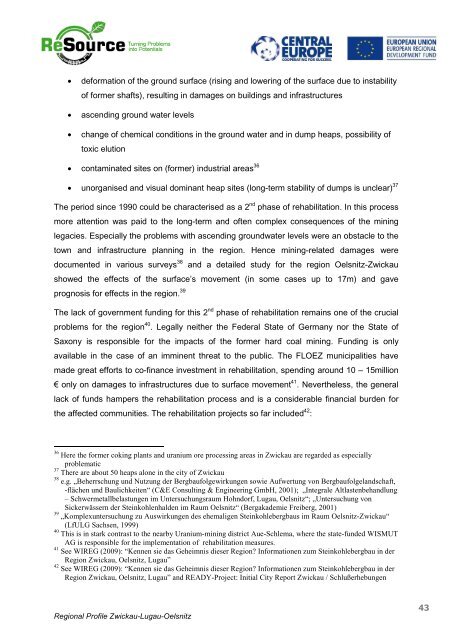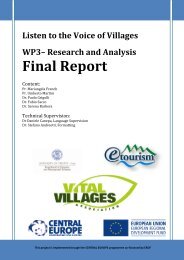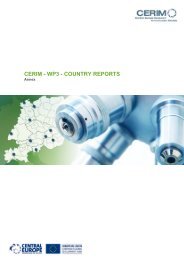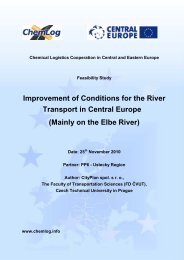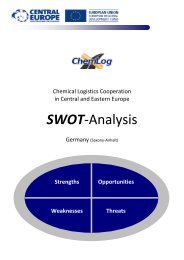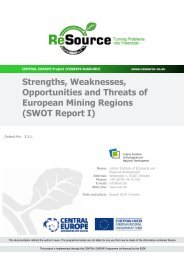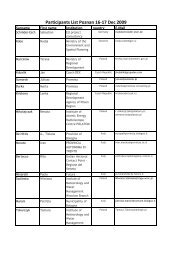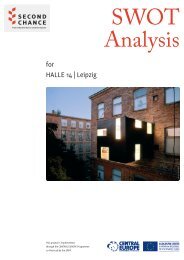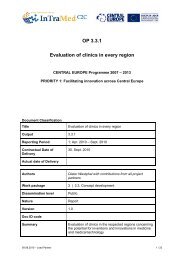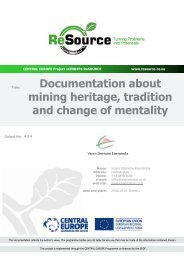Title: Regional Profile Report - Central Europe
Title: Regional Profile Report - Central Europe
Title: Regional Profile Report - Central Europe
Create successful ePaper yourself
Turn your PDF publications into a flip-book with our unique Google optimized e-Paper software.
• deformation of the ground surface (rising and lowering of the surface due to instability<br />
of former shafts), resulting in damages on buildings and infrastructures<br />
• ascending ground water levels<br />
• change of chemical conditions in the ground water and in dump heaps, possibility of<br />
toxic elution<br />
• contaminated sites on (former) industrial areas 36<br />
• unorganised and visual dominant heap sites (long-term stability of dumps is unclear) 37<br />
The period since 1990 could be characterised as a 2 nd phase of rehabilitation. In this process<br />
more attention was paid to the long-term and often complex consequences of the mining<br />
legacies. Especially the problems with ascending groundwater levels were an obstacle to the<br />
town and infrastructure planning in the region. Hence mining-related damages were<br />
documented in various surveys 38 and a detailed study for the region Oelsnitz-Zwickau<br />
showed the effects of the surface’s movement (in some cases up to 17m) and gave<br />
prognosis for effects in the region. 39<br />
The lack of government funding for this 2 nd phase of rehabilitation remains one of the crucial<br />
problems for the region 40 . Legally neither the Federal State of Germany nor the State of<br />
Saxony is responsible for the impacts of the former hard coal mining. Funding is only<br />
available in the case of an imminent threat to the public. The FLOEZ municipalities have<br />
made great efforts to co-finance investment in rehabilitation, spending around 10 – 15million<br />
€ only on damages to infrastructures due to surface movement 41 . Nevertheless, the general<br />
lack of funds hampers the rehabilitation process and is a considerable financial burden for<br />
the affected communities. The rehabilitation projects so far included 42 :<br />
36<br />
Here the former coking plants and uranium ore processing areas in Zwickau are regarded as especially<br />
problematic<br />
37<br />
There are about 50 heaps alone in the city of Zwickau<br />
38<br />
e.g. „Beherrschung und Nutzung der Bergbaufolgewirkungen sowie Aufwertung von Bergbaufolgelandschaft,<br />
-flächen und Baulichkeiten“ (C&E Consulting & Engineering GmbH, 2001); „Integrale Altlastenbehandlung<br />
– Schwermetallbelastungen im Untersuchungsraum Hohndorf, Lugau, Oelsnitz“; „Untersuchung von<br />
Sickerwässern der Steinkohlenhalden im Raum Oelsnitz“ (Bergakademie Freiberg, 2001)<br />
39<br />
„Komplexuntersuchung zu Auswirkungen des ehemaligen Steinkohlebergbaus im Raum Oelsnitz-Zwickau“<br />
(LfULG Sachsen, 1999)<br />
40<br />
This is in stark contrast to the nearby Uranium-mining district Aue-Schlema, where the state-funded WISMUT<br />
AG is responsible for the implementation of rehabilitation measures.<br />
41<br />
See WIREG (2009): “Kennen sie das Geheimnis dieser Region? Informationen zum Steinkohlebergbau in der<br />
Region Zwickau, Oelsnitz, Lugau”<br />
42<br />
See WIREG (2009): “Kennen sie das Geheimnis dieser Region? Informationen zum Steinkohlebergbau in der<br />
Region Zwickau, Oelsnitz, Lugau” and READY-Project: Initial City <strong>Report</strong> Zwickau / Schlußerhebungen<br />
<strong>Regional</strong> <strong>Profile</strong> Zwickau-Lugau-Oelsnitz<br />
43


